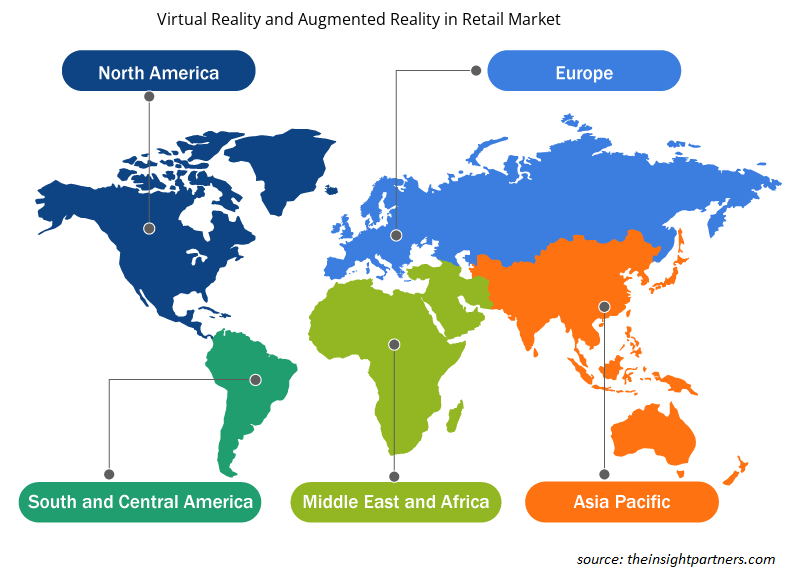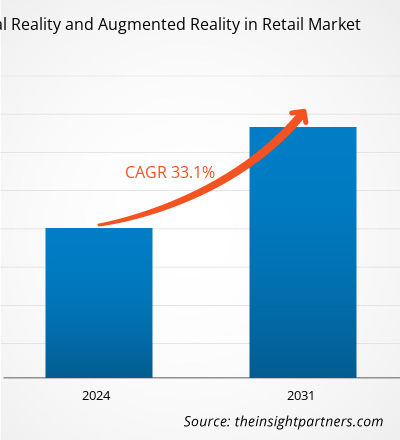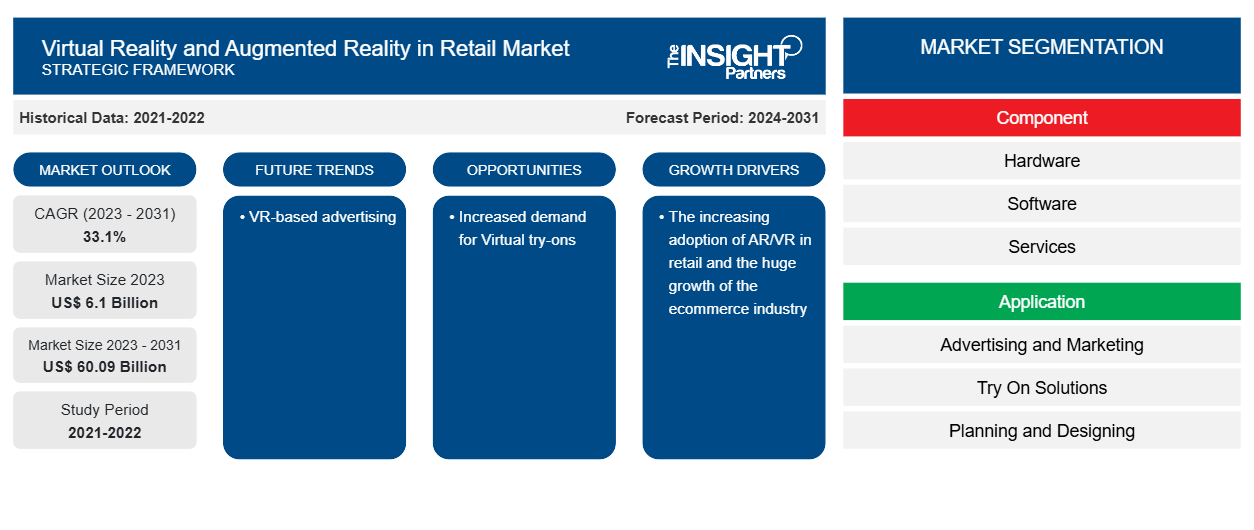Se proyecta que la realidad virtual y la realidad aumentada en el mercado minorista alcancen los 60.090 millones de dólares en 2031, frente a los 6.100 millones de dólares en 2023. Se espera que la realidad virtual y la realidad aumentada en el mercado minorista registren una CAGR del 33,1 % durante 2023-2031. Es probable que la publicidad basada en VR siga siendo una tendencia clave en el mercado.CAGR of 33.1% during 2023–2031. VR-based advertising is likely to remain a key trend in the market.
Realidad virtual y realidad aumentada en el análisis del mercado minorista
La realidad virtual y la realidad aumentada en el comercio minorista incluyen perspectivas de crecimiento debido a las tendencias actuales del mercado y su impacto previsible durante el período de pronóstico. La realidad virtual y la realidad aumentada en el comercio minorista están creciendo debido a factores como la creciente adopción de AR/VR en el comercio minorista y el enorme crecimiento de la industria del comercio electrónico. La mayor demanda de pruebas virtuales brinda oportunidades lucrativas para la realidad virtual y la realidad aumentada en el comercio minorista.
Descripción general del mercado de realidad virtual y realidad aumentada en el comercio minorista
La realidad virtual (RV) y la realidad aumentada (RA) están transformando el panorama minorista al ofrecer experiencias de compra inmersivas e interactivas. La RV crea un entorno totalmente digital donde los clientes pueden explorar tiendas virtuales, visualizar productos en 3D e incluso probarse ropa virtualmente. La RA, por otro lado, superpone información digital sobre el mundo real, lo que permite a los compradores ver cómo lucirían los muebles en sus hogares o cómo luciría el maquillaje en sus rostros mediante aplicaciones de teléfonos inteligentes o espejos inteligentes. Ambas tecnologías permiten a los minoristas cerrar la brecha entre las compras en línea y en la tienda, mejorar la visualización de los productos, reducir las devoluciones y crear experiencias de marca atractivas que pueden impulsar la participación del cliente y las ventas.
Personalice este informe según sus necesidades
Obtendrá personalización en cualquier informe, sin cargo, incluidas partes de este informe o análisis a nivel de país, paquete de datos de Excel, así como también grandes ofertas y descuentos para empresas emergentes y universidades.
-
Obtenga las principales tendencias clave del mercado de este informe.Esta muestra GRATUITA incluirá análisis de datos, desde tendencias del mercado hasta estimaciones y pronósticos.
Realidad virtual y realidad aumentada en el mercado minorista: impulsores y oportunidades
La creciente adopción de AR/VR en el comercio minorista favorece el mercado
Uno de los principales sectores que ha sufrido el impacto de la era digital es el comercio minorista. Los minoristas más importantes, como Walmart, Alibaba y Amazon, invierten activamente en tecnologías de vanguardia para ofrecer servicios más individualizados e interactivos a sus clientes. Tres componentes fundamentales del comercio minorista inteligente son la mayor comodidad, la personalización y la personalización. Las soluciones innovadoras, como las aplicaciones impulsadas por la realidad aumentada y la realidad virtual, están ganando popularidad. Muchos comercios minoristas han comenzado a adoptar la tecnología de realidad aumentada y realidad virtual después de que gigantes minoristas como Wayfair, Lowe's e Ikea lo hicieran. Por ejemplo, se espera que más de mil millones de personas utilicen productos de realidad aumentada. La cifra es asombrosa. La realidad virtual y aumentada facilita a los clientes identificar y probar cosas antes de comprar. La navegación por los grandes centros comerciales será más sencilla gracias al uso de la realidad aumentada.Alibaba, and Amazon, actively invest in cutting-edge retail technologies in order to provide more individualized and interactive services to their customers. Three fundamental components of smart retail are increased convenience, personalization, and customization. Innovative solutions like applications powered by AR and VR are growing in popularity. Many retail businesses have started to adopt AR/VR technology after retail giants like Wayfair, Lowe's, and Ikea. For instance, more than 1 billion people are expected to use augmented reality products. The number is staggering. Virtual and augmented reality makes it easier for customers to identify and try things before buying. Huge shopping mall navigation will be made easier with the use of augmented reality.
Mayor demanda de pruebas virtualesTry-Ons
La mayor demanda de pruebas virtuales presenta oportunidades significativas para la realidad virtual y aumentada en el crecimiento del mercado minorista. Al permitir que los clientes visualicen los productos con mayor precisión antes de la compra, las pruebas virtuales pueden reducir significativamente las tasas de devolución. Esto ahorra dinero a los minoristas en envío y reposición, lo que mejora la rentabilidad. Además, a medida que los clientes ganan confianza en sus compras en línea a través de pruebas virtuales, es más probable que compren artículos sin verlos en persona primero. Esto puede impulsar las ventas de comercio electrónico, especialmente en categorías como ropa y cosméticos . Las pruebas virtuales ofrecen una experiencia de compra novedosa e interactiva que puede aumentar la participación y la satisfacción del cliente. Esto puede generar una mayor lealtad a la marca y compras repetidas.try-ons presents significant opportunities for VR and AR in retail market growth. By allowing customers to visualize products more accurately before purchase, virtual try-ons can significantly reduce return rates. This saves retailers money on shipping and restocking, improving profitability. Moreover, as customers gain confidence in their online purchases through virtual try-ons, they're more likely to buy items without seeing them in person first. This can boost e-commerce sales, especially in categories like clothing and try-ons offer a novel, interactive shopping experience that can increase customer engagement and satisfaction. This can lead to improved brand loyalty and repeat purchases.
Informe de análisis de segmentación del mercado minorista de realidad virtual y realidad aumentada
Los segmentos clave que contribuyeron a la derivación de la realidad virtual y la realidad aumentada en el análisis del mercado minorista son el componente, la aplicación y el tipo de venta minorista.
- En función de los componentes, la realidad virtual y la realidad aumentada en el mercado minorista se dividen en hardware, software y servicios. El segmento de hardware tendrá una cuota de mercado significativa en 2023.
- Por aplicación, el mercado se segmenta en publicidad y marketing, soluciones de prueba, planificación y diseño, entre otros. El segmento de publicidad y marketing tuvo la mayor participación de mercado en 2023.
- En términos de tipo de venta minorista, el mercado está segmentado en joyería, ropa, belleza y cosméticos, muebles, entre otros. El segmento de ropa tuvo la mayor participación de mercado en 2023.
Análisis de la participación de mercado de la realidad virtual y la realidad aumentada en el comercio minorista por geografía
El alcance geográfico del informe sobre el mercado minorista de realidad virtual y realidad aumentada se divide principalmente en cinco regiones: América del Norte, Asia Pacífico, Europa, Medio Oriente y África, y América del Sur y Central.
El uso de la realidad aumentada (RA) y la realidad virtual (RV) en el comercio minorista en la región Asia Pacífico está ganando terreno. Estas tecnologías se utilizan cada vez más de diversas maneras para mejorar la experiencia minorista e impulsar la participación del cliente. Estas tecnologías tienen el potencial de mejorar la experiencia minorista, impulsar la participación del cliente y brindar nuevas oportunidades de marketing, capacitación y educación en la industria.VR) in retail in the Asia Pacific is gaining traction. These technologies are being increasingly utilized in various ways to enhance the retail experience and drive customer engagement. These technologies have the potential to enhance the retail experience, drive customer engagement, and provide new opportunities for marketing, training, and education in the industry.
Realidad virtual y realidad aumentada en el mercado minorista: perspectivas regionales
Los analistas de Insight Partners explicaron en detalle las tendencias y los factores regionales que influyen en el mercado de realidad virtual y realidad aumentada en el comercio minorista durante el período de pronóstico. Esta sección también analiza los segmentos y la geografía del mercado de realidad virtual y realidad aumentada en el comercio minorista en América del Norte, Europa, Asia Pacífico, Oriente Medio y África, y América del Sur y Central.

- Obtenga datos regionales específicos sobre realidad virtual y realidad aumentada en el mercado minorista
Alcance del informe sobre realidad virtual y realidad aumentada en el mercado minorista
| Atributo del informe | Detalles |
|---|---|
| Tamaño del mercado en 2023 | 6.100 millones de dólares estadounidenses |
| Tamaño del mercado en 2031 | US$ 60.09 mil millones |
| CAGR global (2023 - 2031) | 33,1% |
| Datos históricos | 2021-2022 |
| Período de pronóstico | 2024-2031 |
| Segmentos cubiertos |
Por componente
|
| Regiones y países cubiertos |
América del norte
|
| Líderes del mercado y perfiles de empresas clave |
|
Realidad virtual y realidad aumentada en la densidad de actores del mercado minorista: comprensión de su impacto en la dinámica empresarial
El mercado de la realidad virtual y la realidad aumentada en el comercio minorista está creciendo rápidamente, impulsado por la creciente demanda de los usuarios finales debido a factores como la evolución de las preferencias de los consumidores, los avances tecnológicos y una mayor conciencia de los beneficios del producto. A medida que aumenta la demanda, las empresas amplían sus ofertas, innovan para satisfacer las necesidades de los consumidores y aprovechan las tendencias emergentes, lo que impulsa aún más el crecimiento del mercado.
La densidad de actores del mercado se refiere a la distribución de las empresas o firmas que operan dentro de un mercado o industria en particular. Indica cuántos competidores (actores del mercado) están presentes en un espacio de mercado determinado en relación con su tamaño o valor total de mercado.
Las principales empresas que operan en el mercado de Realidad Virtual y Realidad Aumentada en Retail son:
- Epson América, Inc.
- Marxente
- Google LLC
- Infosys Ltd
- Corporación Intel
- Corporación Microsoft
Descargo de responsabilidad : Las empresas enumeradas anteriormente no están clasificadas en ningún orden particular.

- Obtenga una descripción general de los principales actores clave del mercado de realidad virtual y realidad aumentada en el comercio minorista
Realidad virtual y realidad aumentada en el mercado minorista: novedades y desarrollos recientes
La realidad virtual y la realidad aumentada en el mercado minorista se evalúan mediante la recopilación de datos cualitativos y cuantitativos a partir de investigaciones primarias y secundarias, que incluyen publicaciones corporativas importantes, datos de asociaciones y bases de datos. A continuación, se enumeran algunos de los avances en realidad virtual y realidad aumentada en el mercado minorista:
- Apple lanzó su primer casco de realidad mixta, Vision Pro, con 600 nuevas aplicaciones y juegos. Entre ellos, se encuentran incursiones en la realidad aumentada (RA) y la realidad virtual (RV) de los principales minoristas, aprovechando la capacidad de ofrecer a los consumidores recorridos de comercio electrónico más interactivos. La aplicación Vision Pro ofrece a los usuarios de los cascos una experiencia de compra en 3D, lo que les permite examinar los productos y armar atuendos. Además, la integración de la función Apple SharePlay para las videollamadas FaceTime permite al minorista brindar asesoramiento en tiempo real de los estilistas en este entorno realista. (Fuente: Apple, comunicado de prensa, febrero de 2024)VR) from major retailers, taking advantage of the capacity to offer consumers more interactive eCommerce journeys. The Vision Pro app presents headset users with a 3D shopping experience, enabling them to peruse products and assemble outfits. Additionally, the integration of the Apple SharePlay feature for FaceTime video calls enables the retailer to provide real-time advice from stylists in this lifelike environment. (Source: Apple, Press Release, February 2024)
- Zero10 ofrece soluciones digitales a través de espejos de realidad aumentada en las tiendas y en los escaparates de marcas como Tommy Hilfiger y Coach. Tommy Hilfiger también utiliza los espejos de realidad aumentada de la empresa de tecnología Zero10 en Europa como parte de su campaña de Shawn Mendes y para promocionar su reciente lanzamiento de chaquetas acolchadas. Mientras tanto, Coach utiliza el espejo de realidad aumentada y la vitrina de realidad aumentada de Zero10 para publicitar sus campañas de bolsos Tabby y de la temporada navideña (Fuente: Zero10, comunicado de prensa, abril de 2024)
Informe sobre realidad virtual y realidad aumentada en el mercado minorista: cobertura y resultados
El informe “Tamaño y pronóstico del mercado de realidad virtual y realidad aumentada en el comercio minorista (2021-2031)” proporciona un análisis detallado del mercado que cubre las siguientes áreas:
- Realidad virtual y realidad aumentada en el tamaño del mercado minorista y pronóstico a nivel mundial, regional y nacional para todos los segmentos clave del mercado cubiertos bajo el alcance
- Realidad virtual y realidad aumentada en las tendencias del mercado minorista, así como la dinámica del mercado, como impulsores, restricciones y oportunidades clave
- Análisis detallado de las cinco fuerzas de Porter y PEST y FODA
- Análisis de la realidad virtual y la realidad aumentada en el mercado minorista que abarca las tendencias clave del mercado, el marco global y regional, los principales actores, las regulaciones y los desarrollos recientes del mercado
- Panorama de la industria y análisis de la competencia que abarca la concentración del mercado, análisis de mapas de calor, actores destacados y desarrollos recientes para la realidad virtual y la realidad aumentada en el mercado minorista
- Perfiles detallados de empresas
- Análisis histórico (2 años), año base, pronóstico (7 años) con CAGR
- Análisis PEST y FODA
- Tamaño del mercado, valor/volumen: global, regional y nacional
- Industria y panorama competitivo
- Conjunto de datos de Excel
Informes recientes
Testimonios
Razón para comprar
- Toma de decisiones informada
- Comprensión de la dinámica del mercado
- Análisis competitivo
- Información sobre clientes
- Pronósticos del mercado
- Mitigación de riesgos
- Planificación estratégica
- Justificación de la inversión
- Identificación de mercados emergentes
- Mejora de las estrategias de marketing
- Impulso de la eficiencia operativa
- Alineación con las tendencias regulatorias























 Obtenga una muestra gratuita para - Realidad virtual y realidad aumentada en el mercado minorista
Obtenga una muestra gratuita para - Realidad virtual y realidad aumentada en el mercado minorista